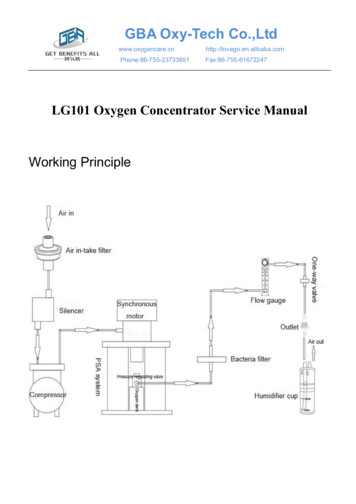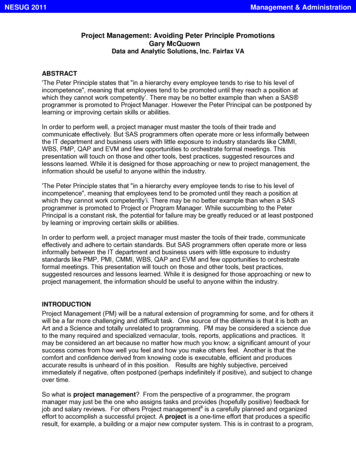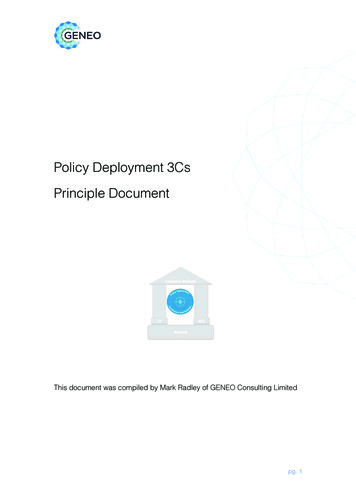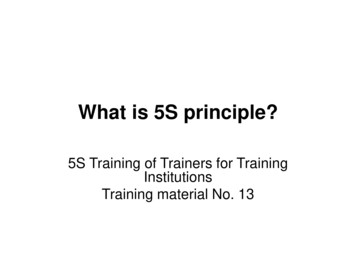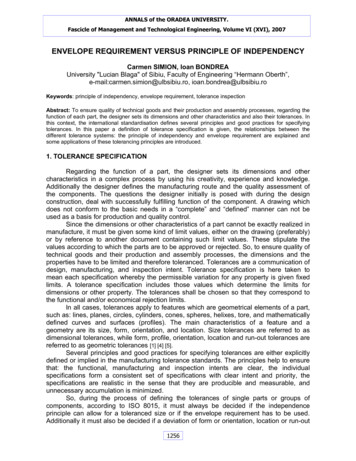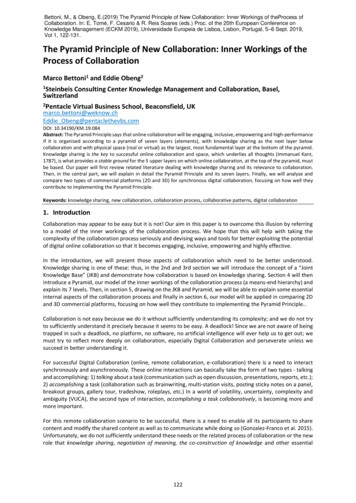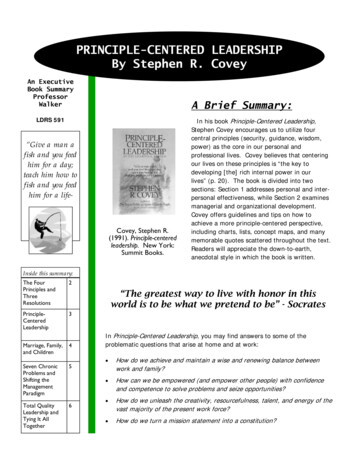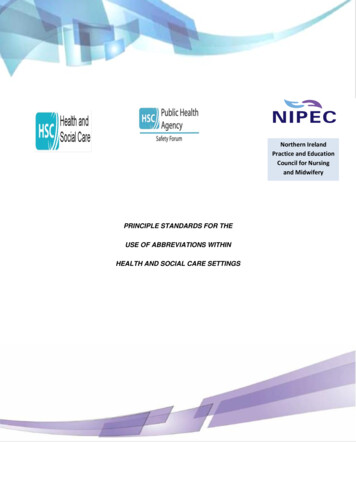
Transcription
Northern IrelandPractice and EducationCouncil for Nursingand MidwiferyPRINCIPLE STANDARDS FOR THEUSE OF ABBREVIATIONS WITHINHEALTH AND SOCIAL CARE SETTINGS
CONTENTSPAGE1.0CONTEXT32.0AIM33.0DEVELOPMENT OF PRINCIPLE STANDARDS44.0PRINCIPLE STANDARDS FOR THE USE OF ABBREVIATIONS WITHINHEALTH AND SOCIAL CARE Appendix 1. Regional agreed core abbreviations8Appendix 2. Commonly used during administration of medicines9Appendix 3. Official “Do Not Use” List of abbreviations10AcknowledgmentNorthern Ireland Practice and Education Council and the Northern Ireland Health and Social CareSafety Forum wish to acknowledge and express thanks to the engagement and valuable inputprovided from the health professionals.Page 2 of 11
1.0CONTEXT1.1. It is widely recognised within healthcare settings that abbreviations and othershortened forms of written communication (e.g. acronyms) can be misinterpretedresulting in significant risks to the quality of care and patient safety. This practiceshould be discouraged and guidance from regulators (NMC 2015) and professionalorganisations (RCN 2014) advise to avoid any inappropriate use of abbreviations. TheWorld Health Organisation (2011) states that patient safety is impacted on by manyfactors, including effective teamwork, accurate and timely communication (verbal andwritten), medication safety, hand hygiene and procedural and surgical skills.1.2. Today’s contemporary health and social care services are set within the context ofmodernisation and change for example new technologies, constrained resources and arange of other significant pressures. The need to continue to change to meetincreasing demands and public expectations is set within this environment; therefore, itis increasingly important that patient safety remains paramount.1.3. In relation to patient documentation and patient safety, evidence has emerged of anincrease in the use of inappropriate abbreviations and other shortened forms of writtencommunication (e.g. text language, acronyms). These are used, albeit with goodintentions as a means of professional shorthand in record keeping practices (NIPEC2010). Their uses however are inappropriate and have been the cause of significantfailings (Dimond, 2005 and ISMP, 2012).2.0AIM2.1The overarching aim of this document is to offer regional direction on an agreedapproach to the use of ‘appropriate abbreviations’ that will ensure record keepingpractice remains contemporaneous and does not compromise patient safety.2.2The rationale therefore for the development of these principle standards is as an ‘aidememoire’ for health and social care staff to support good record keeping practice andto detail the standards that must be applied.2.3The principle standards must be monitored, managed and measured through HSCTrust Governance procedures to provide assurance on the appropriate use ofabbreviations and that only the agreed set of core abbreviations are used. Theseshould be read and applied in conjunction with advice and guidance from professionalbodies and regulators.Page 3 of 11
3.0DEVELOPMENT OF PRINCIPLE STANDARDS3.1The principle standards contained within this document have been developed as adirect result of over two years intensive engagement with health professionals workingwithin policy, commissioning, staff-side and in the direct provision of health and socialcare services within Northern Ireland.3.2Concerns have been raised that developing a core common list of agreedabbreviations could potentially lead to their misuse. Equally however there areconcerns about a lack of professional guidance along with gradual increase in the useof inappropriate abbreviations, in particular an increasing use of ‘text language’ andother shortened forms and acronyms.The “Do Not Use” List created in 2004 by theAmerican Joint Commission responsible for improving health care, provides a usefulguide for organisations (see Appendix 3).3.3Further to discussion and debate across multi-professional groups and in the absenceof Health and Social Care Trust policies, it was evident that regional consistency wasrequired in order to minimise potential harm to patients. It is anticipated that regionalagreement on core abbreviations for use in all settings will assist in strengthening theguidance from professional organisations and regulators.3.4Regarding specialist areas of practice where terminology is largely bespoke to thosefields of practice, further work will be required at regional level to determine appropriateabbreviations for these areas.3.5The principle standards contained in this document provide clear and unambiguousregional direction and aim to enhance and support effective communication, improvepatient safety and provide a common understanding of the language to be used in therecords of service users.Page 4 of 11
4.0PRINCIPLE STANDARDS FOR THE USE OF ABBREVIATIONS WITHIN HEALTH ANDSOCIAL CARE SETTINGSI. Patient safety and patient centred care must be paramount at all times and mustdrive effective communication through good record keeping practices in the useof abbreviationsII.Record keeping practice in all patient/client care records must be legible andeasily understood by all persons who access them, includingpatients/clients/relatives and carers(Nurses and Midwives please refer to the NMC 2015 The Code (Practise effectively -10 (10.1-10.6)Medical Staff please refer to Good Medical Practice (2013) Record your work clearly, accurately andlegibly (Domain 1 (19-21)III. The use of abbreviations or other shortened forms of communication are notpermitted for use, unless they have been approved and are included in regionalpolicy directionsIV. Abbreviations must never be used whilst obtaining consent or in the completion ofdeath certificatesV. Abbreviations must never be used in consent forms or when confirmation ofverbal consent is recorded in a patient’s clinical notesVI. The list of commonly used core abbreviations (see Appendix 1) have had regionalagreement and must be visibly available at the front of the patient/client carerecord, demonstrating the meaning and its abbreviated form (this will requireregular review and audit of patient records)VII. The lists (see Appendix 1 and Appendix 2) must be regularly reviewed throughrobust audit process to provide assurances of safe, effective communicationthrough record keeping practices5.0viii. Specialty lists of abbreviations can only be developed if they are agreed regionally(per speciality) and contain the same overarching principle standards as outlinedCONCLUSIONabove.5.1Patient Safety in all Health and Social Care settings is everybody’s business andrequires the correct behaviours by all Health & Social Care staff. When wecommunicate (in writing or verbally) we have the opportunity to serve our patients andclients well – if we are clear, concise and unambiguous. Since a large number ofadverse events have their origins in unclear or incomplete communication, we mustwork hard to reduce the opportunity for such lapses to happen. This documentrepresents just the start of that work.Page 5 of 11
5.2Adhering to the principle standards for the use of abbreviations will help to minimise therisk to patients and clients, for example the Safe Behaviours Framework (Figure 1)would assist in this process, if adopted by all healthcare employees.Figure 1. Safe Behaviours Framework (Mayo Clinic Health System, 2013)Payattention todetailSupportEach OtherHand earlyHave aquestioningreceptiveattitudePage 6 of 11
REFERENCESDimond, B. (2005) Abbreviations: the need for legibility and accuracy in documentation, BritishJournal of Nursing. 2005 Jun 23-Jul 13;14(12): 665-6General Medical Council (GMC, 2013) Good Medical Practice. LondonInstitute for Safe Medication Practices. (ISMP 2012) List of error-prone abbreviations, symbolsand dose designations, Philadelphia: ISMP. Available from www.ismp.org Accessed 20/11/2014.Joint Commission (2004) Facts about the Official “Do Not Use” List of Abbreviationshttp://www.jointcommission.org/facts about do not use list/ accessed Jan 2016Mayo Clinic Health System (2013) Safe Behaviours Framework http://www.mayoclinic.org/accessed Jan 2016Northern Ireland Practice and Education Council for Nursing and Midwifery, (NIPEC,2010) Improving Record Keeping accessible at chievements/impr-rec-keep-practice-in-ni/Nursing and Midwifery Council. (NMC, 2015) The Code Professional standards of practice andbehaviour for nurses and midwives NMC, LondonRoyal College of Nursing (RCN, 2014) Abbreviations and other short forms in patient/clientrecords. LondonWorld Health Organisation (WHO, 2011) Patient Safety Curriculum Guide: Multi-professionalEdition MaltaPage 7 of 11
APPENDIX 1REGIONAL AGREED - CORE CLINICAL ABBREVIATIONSABBREVIATIONAFAMANTTBPC. CSLSTATSRCSOBOETds/tidTempVFVTMEANINGAtrial FibrillationMorningAseptic Non Touch TechniqueBlood PressureClostridium difficileCardiopulmonary ResuscitationCentral Nervous SystemContrary to Medical adviceDirect Current CardioversionDid Not AttendDo Not Attempt Cardiopulmonary ResuscitationDeep Venous ThrombosisHeart RateHistory OfLocal AnaestheticLast Menstrual PeriodMyocardial InfarctionMillilitreMillimoleMethicillin-Resistant Staphylococcus AureusMethicillin Sensitive Staphylococcus AureusNo abnormalities detectedNasogastricNo Known Drug AllergyNightPatient Controlled AnalgesiaPercutaneous Endoscope GastrostomyPatient Group DirectionEveningPer OrallyPer RectumAs RequiredPer VaginaFour Times DailyRespiratory RateSubcutaneousSublingualOne offSelf-Retaining CatheterShortness of Breath on ExertionThree times dailyTemperatureVentricular FibrillationVentricular TachycardiaPage 8 of 11
APPENDIX 2COMMONLY USED DURING ADMINISTRATION OF ANocteodPOPCAPRprnPVqidSCSLTds/tidMEANINGTwice DailyIntramuscularInhaled, inhalational, by olenebulisedNasogastricNo Known Drug AllergyNightOnce a dayPer OrallyPatient Controlled AnalgesiaPer RectumAs RequiredPer VaginaFour Times DailySubcutaneousSublingualThree Times DailyPage 9 of 11
APPENDIX 3THE OFFICIAL “DO NOT USE” LIST OF ABBREVIATIONS (Joint Commission, 2004)In 2004, the American Joint Commission created a “Do Not Use” List as part of its InformationManagement standards, to improve patient safety, although it did not apply to pre-programmedhealth information technology (IT) systems (for example, electronic medical records or CPOEsystems.OFFICIAL “DO NOT USE” LISTDo Not UsePotential ProblemUse InsteadU, u (unit)Mistaken for “0” (zero), thenumber “4” (four) or “cc”Write "unit"IU (International Unit)Mistaken for IV (intravenous)or the number 10 (ten)Write "Unit"Q.D., QD, q.d., qd (daily)Q.O.D., QOD, q.o.d, qodMistaken for each otherPeriod after the Q mistakenfor "I"and the "O" mistaken for "IWrite "daily"Trailing zero (X.0 mg)*Lack of leading zero (.X mg)Decimal point is missedWrite X mgWrite 0.X mgMSMSO4 and MgSO4Can mean morphine sulphateor magnesium sulphateConfused for one anotherWrite "morphine sulphate"Write "magnesium sulphate"(every other day)Write "every other day"This applies to all orders and all medication-related documentation that is handwritten (includingfree-text computer entry) or on pre-printed forms.*Exception: A “trailing zero” may be used only where required to demonstrate the level ofprecision of the value being reported, such as for laboratory results, imaging studies that reportsize of lesions, or catheter/tube sizes. It may not be used in medication orders or other medicationrelated documentation.Page 10 of 11
For further Information, please contactNIPECCentre House79 Chichester StreetBELFAST, BT1 4JETel: 0300 300 0066This document can be downloaded from the NIPEC website https://nipec.hscni.netRevised August 2016ISBN: 978-1-903580-53-0
The use of abbreviations or other shortened forms of communication are not s IV. Abbreviations must never be used whilst obtaining consent or in the completion of death certificates V. Abbreviations must never be used in consent forms or when confirmation of verbal consent is recorded in a patient’s clinical notes VI. The list of commonly used core abbreviations (see Appendix 1) have had regional


